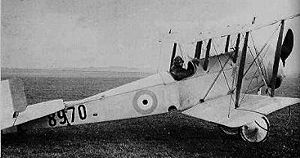
Scout (aircraft)
Encyclopedia

World War I
World War I , which was predominantly called the World War or the Great War from its occurrence until 1939, and the First World War or World War I thereafter, was a major war centred in Europe that began on 28 July 1914 and lasted until 11 November 1918...
, and referred to a light (usually single-seat) reconnaissance
Reconnaissance
Reconnaissance is the military term for exploring beyond the area occupied by friendly forces to gain information about enemy forces or features of the environment....
aircraft, initially unarmed. "Scout" types were generally adaptations of pre-war racing aircraft – although at least one (the Royal Aircraft Factory S.E.2
Royal Aircraft Factory S.E.2
|-See also:-References:NotesBibliography*Bruce, J.M. British Aeroplanes 1914-18. London: Putnam, 1957.*Bruce, J.M. The Aeroplanes of the Royal Flying Corps . London: Putnam, 1982. ISBN 0-370-30084-X....
) was specifically designed for the role. At this stage the possibility of air-to-air combat was considered highly speculative, and the speed of these aircraft relative to their contemporaries was seen as an advantage in gaining immunity from ground fire and in the ability to deliver timely reconnaissance reports.
Almost from the beginning of the war, various experiments were carried out in the fitting of armament to scouts to enable them to engage in air-to-air combat – by early 1916 several types of scout could fire a machine gun
Machine gun
A machine gun is a fully automatic mounted or portable firearm, usually designed to fire rounds in quick succession from an ammunition belt or large-capacity magazine, typically at a rate of several hundred rounds per minute....
forwards, in the line of flight, thus becoming the first effective single-seat fighters
Fighter aircraft
A fighter aircraft is a military aircraft designed primarily for air-to-air combat with other aircraft, as opposed to a bomber, which is designed primarily to attack ground targets...
– in effect, an entirely new class of aircraft. In French and German usage these types were termed "hunters", but in the Royal Flying Corps
Royal Flying Corps
The Royal Flying Corps was the over-land air arm of the British military during most of the First World War. During the early part of the war, the RFC's responsibilities were centred on support of the British Army, via artillery co-operation and photographic reconnaissance...
and early Royal Air Force
Royal Air Force
The Royal Air Force is the aerial warfare service branch of the British Armed Forces. Formed on 1 April 1918, it is the oldest independent air force in the world...
parlance "scout" remained the usual term for a single seat fighter into the early 1920s. The term "fighter" was already current, but in this period referred specifically to a two-seater fighter such as the Sopwith 1½ Strutter
Sopwith 1½ Strutter
The Sopwith 1½ Strutter was a British one or two-seat biplane multi-role aircraft of the First World War. It is significant as the first British-designed two seater tractor fighter, and the first British aircraft to enter service with a synchronised machine gun...
or the Bristol Fighter
Bristol F.2 Fighter
The Bristol F.2 Fighter was a British two-seat biplane fighter and reconnaissance aircraft of the First World War flown by the Royal Flying Corps. It is often simply called the Bristol Fighter or popularly the "Brisfit" or "Biff". Despite being a two-seater, the F.2B proved to be an agile aircraft...
.
This usage ("scout" or sometimes "fighting scout" for "single-seat fighter") can be found in many contemporary accounts, including fictional depictions of First World War air combat such as the Biggles
Biggles
"Biggles" , a pilot and adventurer, is the title character and main hero of the Biggles series of youth-oriented adventure books written by W. E. Johns....
books. These often refer to French or German "scouts" as well as British ones.
The usage also survives in some much later non-fictional writing on First World War aviation.

